

Larry Hicks was diagnosed with significant hearing loss about six months ago. He blames it, with a bit of embarrassment, on blasting music at crazy-high levels in the car.
The Burbank resident is now shopping for hearing aids and is stunned by the cost, which can run as much as $6,000 for a pair. Medicare and most private plans don’t cover hearing aids.
“It feels like price gouging,” Hicks, 51, told me. “They’re taking advantage of the disabled and the elderly.”
It’s hard to disagree. Medical devices are a prime example of a relative handful of manufacturers exploiting a captive market with excessively high list prices.
Whether we’re talking hearing aids, insulin pumps, pacemakers or other life-altering technologies, patients almost always are forced to pay far more than the cost of developing and making the devices.
“The medical device industry is largely an oligopoly, with some of the companies holding effectively a monopoly position,” said Roberta N. Clarke, an adjunct professor of social policy and management at Brandeis University, specializing in healthcare marketing.
Limited competition, she told me, “allows the medical device companies to charge higher prices because of a lower threat of a competitor entering the market at a lower price.”
“This effect is exacerbated by the tight relationships that the medical device companies form with physicians,” Clarke observed.
There’s so much wrong with the $4-trillion U.S. healthcare system, it’s hard to know where to start fixing it. Maybe that’s one reason lawmakers are so reluctant to try.
I wrote the other day about starting with price transparency. I made the case for hospitals and doctors emulating Amazon’s straightforward presentation of costs prior to customers making a purchase.
High-priced medical devices represent another area ripe for reform — another step toward creating a healthcare system that doesn’t relentlessly put profits ahead of patients.
We have the world’s largest market for medical devices, which should come as no surprise in light of America’s population, wealth and technological prowess.
A recent report from Grand View Research estimates that about $177 billion worth of medical devices were sold in this country last year. Sales this year are projected to reach $186.5 billion.
By 2028, the report forecasts, U.S. sales of medical devices will reach $262.4 billion — a roughly 48% increase from last year’s total.
“The rising prevalence of chronic diseases and the increasing geriatric population in the country are the key market drivers,” Grand View’s researchers concluded.
Defenders of the healthcare status quo will be quick to play the innovation card. They’ll argue that the high cost of medical devices encourages businesses to continue seeking technological advances, which in turn can help save lives.
There’s something to this. Look at the billions invested in developing COVID-19 vaccines in record time. No drug company or research lab got into that race without an expectation of a massive payday down the road.
But, as with all questions of healthcare costs, the key issue is how much profit is enough.
No one begrudges device makers or drug companies earning a reasonable profit or recouping multimillion-dollar R&D expenses. That’s only fair.
The problem with the status quo is that prices never seem to go down. Even after R&D and marketing costs have been amortized many times over, even after economies of scale have been realized, list prices keep rising.
All other cutting-edge consumer goods — TVs, laptops, cellphones — get cheaper over time, reflecting how competitive their markets are.
Most medical devices and prescription drugs just get more expensive as time passes. In large part, this is because these markets have costly barriers to entry (R&D, patents, etc.). The products also require strict regulatory approval.
Less competition almost always means higher prices.
But let’s call this what it is: taking advantage of sick people.
“Taking advantage of sick people is wrong,” acknowledged Matthew Grennan, an assistant professor of healthcare management at the University of Pennsylvania. “But I’m not sure where the line is.”
By that, he means it can be hard from an economic perspective to flat-out reject sky-high prices for medical advances.
“Medical devices are this weird class of goods where the manufacturing cost is relatively low but the value they create is high,” Grennan told me.
The creation of “value” is a big deal in the healthcare industry. The argument is basically that treating an illness or managing a chronic disease brings so much value to society, you can charge as much as you want.
When the pharmaceutical company Gilead Sciences introduced its hepatitis C drug Harvoni in 2014 with a list price of more than $1,000 a pill, it defended that mercenary move by saying, “The price of Harvoni reflects the value of the medicine.”
Not how much it cost to develop. Not how much it costs to make. The “value” to patients and society. And what value do you place on human lives?
Grennan said economists appreciate that argument. “Value” is a legitimate economic proposition and it has worth.
As a person forced to pay thousands of dollars annually managing a chronic disease, I say “value” is just an excuse for businesses to write themselves blank checks.
At some point, a drug’s or device’s value to society needs to be accepted as the new normal, and it has to be priced accordingly.
Let’s get back to hearing aids, which, as noted above, routinely cost thousands of dollars — a cost borne directly by the majority of people with hearing problems because most insurers don’t cover them.
As best as I can tell, nearly all of the key components for hearing aids come from Asia, and many are manufactured there as well.
It’s hard to know how much it costs to make a hearing aid. There are references in the New York Times and elsewhere to a manufacturing price as low as $100.
Grennan called this a realistic estimate. A fancier hearing aid may cost $200 or $300 to produce, he said.
A 2015 report by former President Obama’s Council of Advisors on Science and Technology placed the typical list price of a single hearing aid at $2,400 — a 1,100% markup if the device cost $200 to produce.
The report noted that “innovation has not reduced cost,” and that nearly half of all people ages 60 and older have hearing loss.
Captive market. Steadily rising prices. Huge markups.
That’s not value. It’s immoral.
